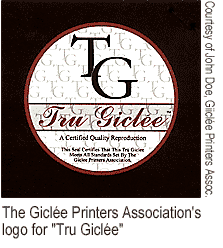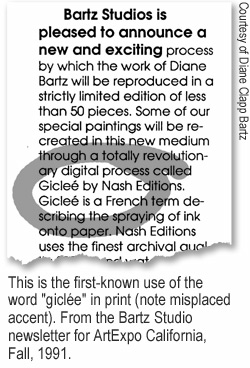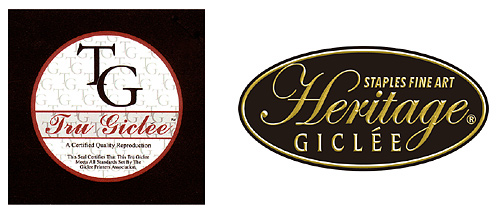|
|
Printing Insights #019What's In a Name: The Story of Giclée
|
|
|
|
| One thing that became quickly apparent to the early
digital pioneers was the lack of a proper name to describe the prints
they were making. By the close of the 1980s, IRIS printers were installed
all over the world and spinning off full-color proofs in commercial printing
plants and pre-press shops. These prints were used to check color and
get client approvals before starting the main print run. They definitely
were not meant to last or to be displayed on anyone's walls. Most people
called them "IRIS prints," or "IRIS proofs," or,
more simply, "IRISes."
However, this wasn't good enough for the new digital printmakers like Maryann Doe of Harvest Productions and Jack Duganne, who was the first printmaker (after David Coons) at Nash Editions. They wanted to draw a distinction between the beautiful prints they were laboring over and the utilitarian proofs the commercial printers were cranking out. Just like artist Robert Rauschenberg did when he came up with the term "combines" for his new assemblage art, they needed a new label, or, in marketing terms, a "brand identity." The makers of digital art needed a word of their own.
And, in 1991, they got it. Duganne had to come up with a print-medium description for a mailer announcing California artist Diane Bartz' upcoming show. He wanted to stay away from words like "computer" or "digital" because of the negative connotations the art world attached to the new medium. Taking a cue from the French word for inkjet (jet d'encre), Duganne opened his pocket Larousse and searched for a word that was generic enough to cover most inkjet technologies at the time and hopefully into the future. He focused on the nozzle, which most printers used. In French, that was le gicleur. What inkjet nozzles do is spray ink, so looking up French verbs for "to spray," he found gicler, which literally means "to squirt, spurt, or spray." The feminine noun version of the verb is (la) giclée, (pronounced "zhee-clay") or "that which is sprayed or squirted." An industry moniker was born. However, the controversy started immediately. Graham Nash and Mac Holbert had come up with "digigraph," which was close to "serigraph" and "photograph." The photographers liked that. But, the artists and printmakers doing reproductions had adopted "giclée," and the term soon became a synonym for "an art print made on an IRIS inkjet printer." Today, "giclée" has become established with traditional media artists, and some photographers. But many photographers and other digital artists have not accepted it, using, instead, labels such as "original digital prints," "inkjet prints," "pigment prints," or "(substitute the name of your print process) prints." For many artists, the debate over "giclée" continues. Some object to its suggestive, French slang meaning ("spurt"). Others believe it is still too closely linked to the IRIS printer or to the reproduction market. And some feel that it is just too pretentious. But, for many, the term "giclée" has become part of the printmaking landscape; a generic word, like Kleenex, that has evolved into a broader term that describes any high-quality, digitally produced, fine-art print. One problem, of course, is that when a term becomes too broad, it loses its ability to describe a specific thing. At that point, it stops being a good marketing label--and make no mistake about it, "giclée" is a marketing term. When everything is a giclée, the art world gets confused, and the process starts all over again with people coming up with new labels. This is exactly what happened when a new group formed in 2001--the Giclée Printers Association (GPA)--and came up with its own standards and its own term: "Tru Giclée." The GPA is concerned with reproduction printing only, and its printmaker members must meet nine standards or principles in order for them (and their customers) to display the Tru Giclée logo. In 2003, recognizing that only a small number of printmakers could meet the requirements of Tru Giclée, the GPA instituted a lower-threshold standard, "Tru Décor," which applies to the much larger decor-art market.
Others have also climbed onto the giclée bandwagon with such variations as "Platinum Giclée" (Jonathan Penney's term for his black-and-white printmaking process), "Canvas Photo Giclée" (a California photo printmaking shop), and "Heritage Giclée" (Staples Fine Art's trademarked term for its brand of giclée printmaking -- see image above, which actually preceded Tru Giclée by 18 months). And now Epson itself has coined "UltraGiclée" in 2005 to designate prints made with its printers, UltraChrome inks, and related media. giclée (zhee-clay) n. 1. a type of digital fine-art print. 2. Most often associated with reproductions; a giclée is a multiple print or exact copy of an original work of art that was created by conventional means (painting, drawing, etc.) and then reproduced digitally, typically via inkjet printing. First use in this context by Jack Duganne in 1991, Los Angeles, California. Copyright © 2002-2005 Harald Johnson. All rights reserved. |
|
| For Comments post in our News Group |










